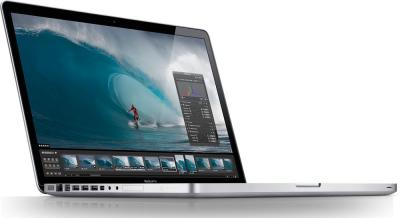Apple 17-Inch MacBook Pro Is A Head-Turner

Apple’s top laptop model has top model looks and is the thinnest and lightest in its category, boasting up to 8 hours battery life.
The first thing l noticed about Apple’s 17-inch MacBook Pro notebook, which earned an eWEEK Analyst’s Choice award, is the appealing fit and finish. The solid aluminium unibody enclosure operates smoothly, from the opening of the magnetic clasp, to the smooth swing of the display, to the seamless undercarriage.
Announced in January and available since mid-February, the 17-inch MacBook Pro ranges in price from £1,949 for the unit I tested to £3,593.99. The MacBook Pro I tested came equipped with a 2.66 GHz Intel Core 2 Duo processor, 4GB 1066 MHz DDR3 RAM, a 320GB Serial ATA drive and an internal optical drive. It also came with the high-resolution glossy widescreen display.
The 17-inch MacBook Pro comes with two different graphics processors (GPUs), both from Nvidia. For power-saving utility work, there is the 9400M PCI GPU. For high-resolution graphics editing and gaming, there is the 9600M GT PCIe with 512MB of GDDR3 memory. Switching between the two requires the user to log-in again, and the difference in the GPUs’ power usage is substantial; the high-performance 9600M GT PCIe GPU should be used only when connected to external power.
The 17-inch MacBook Pro is visually impressive. However, what can’t be seen is equally striking; the built-in 95-watt-hour lithium-polymer battery. Apple engineers designed this battery to last for 1,000 charges, for an estimated life-span of five years. The battery charge provides up to eight hours of continuous, very light-duty use (with all power-saving features set to maximum, no use of the internal optical drive and the wireless network adapter active).
During tests at eWEEK Labs in San Francisco, we were able to reproduce that kind of battery life using the MacBook Pro. Even under heavier workloads, for example using the internal optical drive, the battery still provided close to five hours of continuous operation.
Apple provides several options for when your battery finally dies, ranging from a £99 battery replacement from Apple, to full system recycling. The only drawback that I found during testing is that users who often process heavy workloads in places where AC power is not available will find the sealed battery problematic since there is no way to pop in a fresh one. This is a real drawback, and could make some field work, such as managing plans at remote construction sites and survey work, off-limits for the 17-inch MacBook Pro.
The Multi-Touch trackpad that was introduced last October in the MacBook family, is outstanding. The entire trackpad is the button, there is no longer a button bar at the bottom of the pad and there are myriad ways to configure one-, two-, three- and four-finger gestures to customise navigation and image handling.
The trackpad is responsive without being susceptible to stray gestures, due to the separation of the palm/wrist resting area from the the trackpad. The large trackpad is also in proportion to the 17-inch display, which makes it easy to accurately move the pointer to the intended screen location.
There is one design choice that momentarily hampered my full use of the 17-inch MacBook Pro. Despite having nearly 163 square inches (1000 cm²) of surface area, the full-size keyboard lacks several convenient navigation keys, including [page up/down] and [home/end]. It was easy enough to use the key combination of [function] plus [up/down arrow], but I’d prefer a single key for these common actions.